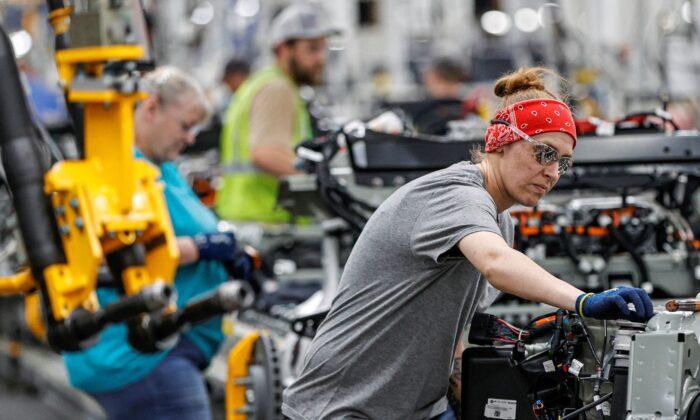American business activity slowed down in May as higher prices reduced demand for services, while lockdowns in China and the ongoing conflict in Ukraine caused chaos in the supply chains.
S&P Global released its May U.S. Composite PMI Output Index survey on May 24, which tracks the manufacturing and services sector throughout the country. The index fell to a reading of 53.8 from 56 in April.
A reading on the index above 50 indicates growth in the private sector.
Manufacturers and service providers saw the slowest growth pace in four months, which was attributed to “elevated inflationary pressures, a further deterioration in supplier delivery times and weaker demand growth.”
“Growth has slowed since peaking in March, most notably in the service sector, as pent up demand following the reopening of the economy after the Omicron wave shows signs of waning.”
However, the results showed improved economic growth halfway through the second quarter, after the economy contracted in the first quarter by 1.4 percent due to a record trade deficit.
The growth was due to increased client demand, but the pace of expansion was slowed down by rising prices and concerns over higher interest rates.
“Companies report that demand is coming under pressure from concerns over the cost of living, higher interest rates and a broader economic slowdown,” said Williamson.
Domestic demand, however, remained solid in the last quarter, as Americans increased spending and businesses ramped up investment in equipment.
Manufacturers and services across the United States continued to hire more workers in May despite a worker shortage, as staffing numbers rose in line with reports of increased new order inflows and further pressure on capacity, causing the rate of growth in work backlogs to decline to a three-month low.
Companies continued to hire staff midway through the second quarter at the fastest pace in 13 months.
U.S. inflation increased at the fastest pace in 40 years, prompting the Federal Reserve to start raising interest rates in March and again in May with a new aggressive monetary policy.
An expected five additional rate hikes by the central bank and worsening financial conditions are raising fears of a recession within the next twelve months.
S&P’s flash manufacturing PMI survey decreased to a reading of 57.5 in May from 59.2 in April, which was in line with expectations.
Manufacturing accounts for 12 percent of the U.S. economy.
An overall improvement in operating conditions across the manufacturing sector was largely positive according to trends.
There were “strong and steep expansions in output and new orders respectively, alongside a faster upturn in employment and longer supplier lead-times.”
The survey’s measure of factory output eased to 55.2 in May from 57.6 in April amid “further reports of raw material shortages and delays in supplier delivery times,” which increased the rate of unfinished work backlogs.
“Manufacturers in particular also report that capacity continues to be constrained by supply shortages, though these bottlenecks showed further encouraging signs of easing,” according to Williamson.
The Chinese Community Party’s (CCP) “Zero COVID-19 policy” led to the shutdown of the Shanghai metropolitan region, which is a major supplier of raw materials to factories in the United States.
The survey’s measure of prices paid for inputs by manufacturers accelerated to 84.9 this month from 81.9 in April.
The S&P’s flash services sector PMI, which makes up more than two-thirds of U.S. economic activity, dropped to a reading of 53.5 this month from 55.6 in April, below the expected forecasts.
The rate of growth eased to its lowest levels in four months, well below March’s recent high.
Service providers witnessed the slowest uptick in new business since the pandemic, as price hike reduced demand and as the initial stimulus boost after the reopening of the economy began to fade.
Meanwhile, the S&P flash composite orders index slipped to 54.4 in May from 56.6 in April.
“Despite all of the headwinds facing businesses, the survey data remain indicative of the economy growing at an annualized rate of 2%, which is also supporting stronger payroll growth,” said Williamson.
“However, cost pressures have risen to a new survey high which, alongside the encouraging output and employment numbers, will fuel further speculation about the need for further imminent aggressive rate hikes,” he concluded.
The cost pressures are due to supplier-driven price hikes for a wide variety of goods and services as demand often continues to outstrip supply, as well as higher interest rates, wage bills, fuel costs, and higher transportation fees.
Business confidence across the private sector still remains upbeat, with firms reporting a stronger outlook on output this May through the rest of 2022.
Companies are hopeful that continuous sales growth and increased investment in local supply chains will ease bottleneck issues.
Although the degree of positive sentiment was higher in May than April, it was below levels at the beginning of the year, amid concerns regarding inflation and customer spending patterns.





